|
Exhibition
The
Archeology of Myths
Mustafa
Zaman
Through
the recent painting that measures 100x10 ft, Ronni Ahmed recollects
myths and folklores by applying his own brand of imagery.
It is
a meditation on Noah's Ark with a flurry of excitingly disjointed
ideas interlaced in one dramatic tableau; it is the Magnum
Opus of Ronni Ahmed.
This 100-foot-long
saga, told in an exquisitely surreal language, is the stuff
of imagination brought into existence to stimulate the imagination.
It is a gargantuan mix of tales told in a hyperbolic code.
It is a cerebral action painting that lays its faith on an
orgy of seemingly disparate visual elements. A Biblical tale
recontextualised to fit into a spectrum of ideas that harp
on personal fantasy and collective memories, the acrylic on
canvas is titled, "The Archeology of Noah's Arc".
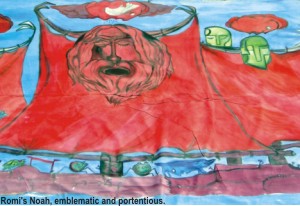 Coursing
through its body is the ever-powerful idiosyncratic current
that Ronni thrives on. In his prolific and forceful hand all
forms take on a different dimension. Even the tiger is twisted
to the extreme to look like a cross between an exotic snake
and the four-legged mammal, the ominous clouds that hover
in the vast sky turn into rain-spewing beasts, the invading
Ikhtiar Uddin Mohammad Bokhtiar Khiljee with his 17 armed
men are like apparitions -- at once ethereal and beastly.
There is even intentional anachronism; from the oil-lamp associated
with one of the Arabian Nights' tale there is a rocket shooting
through the clouds. Even Spiderman and batman appear in a
cameos looking like hybrids. Coursing
through its body is the ever-powerful idiosyncratic current
that Ronni thrives on. In his prolific and forceful hand all
forms take on a different dimension. Even the tiger is twisted
to the extreme to look like a cross between an exotic snake
and the four-legged mammal, the ominous clouds that hover
in the vast sky turn into rain-spewing beasts, the invading
Ikhtiar Uddin Mohammad Bokhtiar Khiljee with his 17 armed
men are like apparitions -- at once ethereal and beastly.
There is even intentional anachronism; from the oil-lamp associated
with one of the Arabian Nights' tale there is a rocket shooting
through the clouds. Even Spiderman and batman appear in a
cameos looking like hybrids.
Other
innumerable hybrids aside, the protagonist, Noah, is a large,
portentous head painted on an expanding red sail. It spreads
over the mid-zone of the canvas providing it a point of focus.
Hanging on the top of the lateral sails are three sons of
Noah, transformed intomere logos. "They mimic the cubist
way of deconstructing a face following a certain spatial order,"
says their creator. With the rest, the policy is plain and
simple: faith in fluidity, or in stretching the forms to extreme
to facilitate hybridisation.
Rony's
art has an inner-dynamics that brings two seemingly conflicting
ideas under one umbrella. The primordial in man meets the
post-verbal-era considerations in his art. Then again, one
must wake up to the fact that it is after we learnt language
that humans were able to grapple with as well as properly
define things that are irrational and absurd, -- emotions
that go back to the non-verbal-era reality. Ronni brings on
the magic of both the worlds, -- the visual strength of the
world before language and the ever-increasing possibility
of expansion of that world in the presence of language.
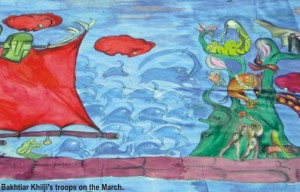 The
art world of Bangladesh is stilted on the notion that text,
or to put it plainly language, has no role to play in art.
Ronni has proved that this notion is passé. By resorting
to a Biblical theme and by introducing the folklore of different
origins to help build his grand vision he has created a horizon
full of possibilities. With Ronni the references are just
plain cues to enter a fantastic domain. The
art world of Bangladesh is stilted on the notion that text,
or to put it plainly language, has no role to play in art.
Ronni has proved that this notion is passé. By resorting
to a Biblical theme and by introducing the folklore of different
origins to help build his grand vision he has created a horizon
full of possibilities. With Ronni the references are just
plain cues to enter a fantastic domain.
No matter
how the viewers want their references, Ronni will never serve
them unscrambled. Though with "The Archeology of Noah's
Ark", he could've been more politically motivated as
he usually is. But this time around, he opted for the power
of image rather than critical reflection on futility of knowledge
and civilization, which has been the focus in his last show
titled "Mythoronnia".
From the
order of things expressed in the recent opus (where the Ark
is like an object of contemplation) as well as from their
constitutions, it becomes obvious that Ronni lays his hope
in the world of subtexts, which is the domain of the mystics
and visionaries. Through the plethora of images that crowds
the huge boat and the couple of chunks representing the shores
(one of which represent the Biblical mountain, Ararat) the
desire to transcend reality is discernable. He says, "The
boat and Noah have relevance in the present context. As we
live in a turbulent time, perhaps a figure like Noah would
ignite the hope for our salvation, or perhaps it is Noah's
boat that is carrying everything from chaos to what we consider
the source of goodness." If the second proposition of
the artist is considered, then there is a greater need for
a father figure, one who is lead us to deliverance.
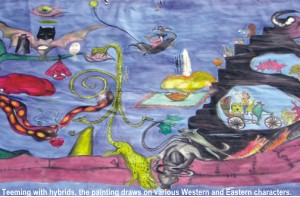 The
work took one month to finish. "It dawned on me that
there is this tradition of art in Bangladesh that negates
story telling. I spent almost six months thinking about the
possibility to base my work on a well-known myth, I found
that Noah's Ark provides me with the chance to incorporate
lots of other myths, fables and axioms which would make the
idea more capacious," Ronni relates. He deliberately
chose the mode of the travelling salesmen who used to carry
hand-drawn pictures to advertise their wares. Though the draughtsmanship
that Ronni applies tries to emulate low-art sensibility, in
the end, his proposition is a poetic adventure into the domain
of popular myths and folklore. The
work took one month to finish. "It dawned on me that
there is this tradition of art in Bangladesh that negates
story telling. I spent almost six months thinking about the
possibility to base my work on a well-known myth, I found
that Noah's Ark provides me with the chance to incorporate
lots of other myths, fables and axioms which would make the
idea more capacious," Ronni relates. He deliberately
chose the mode of the travelling salesmen who used to carry
hand-drawn pictures to advertise their wares. Though the draughtsmanship
that Ronni applies tries to emulate low-art sensibility, in
the end, his proposition is a poetic adventure into the domain
of popular myths and folklore.
"The
Archeology of Noah's Ark" is full with Ronni's own interpretations;
it was open for public viewing from 18 to 28 February at La
Galerie, Alliance Franchaise, Dhaka.
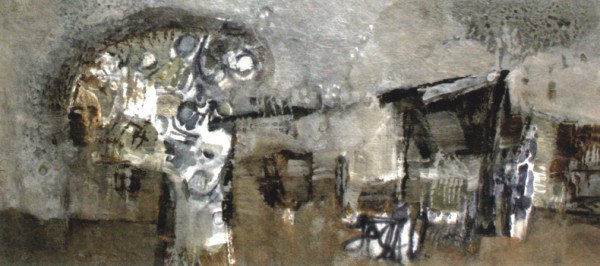
Composition,
2004.
Morphed
Nature
Teeming
with riveting lines and forms, Golam Faruque Bebul's exhibtions
of a large number of smallish paintings is a feast for the
eye. They are works where the retinal experience is transposed
to images that stimulate vision. This 40-plus artist fittingly
calls his exhibition "Nature and Life". Though most
of his works veer to abstractions, Faruque is not a purist
Abstractionist. His works amass a lot of elements that spring
from his direct confrontation with his surroundings. "I
have based my images on experience of looking at nature, rural
Bangladesh plays a crucial role in my art," the artist
was heard explaining to an admirer while coursing through
the rooms of Gallery Chitrak, where his exhibition was launched
on the February 18.
If his
tendency to use biomorphic forms in a certain order is a guide,
Golam Faruque's art is embedded in the tradition of the 70's
and the 80's. It is during this time that few regional artists,
taking their cue from Shafiuddin Ahmed and Kazi Abdul Baset,
made an effort to reconcile European Abstraction with the
natural splendour of Bangladesh. That indigenous tendency
has gelled in Faruque's art. He is the latest name to have
aligned with the few who comfortably straddle the line between
modern formalism and bio-derived art form.
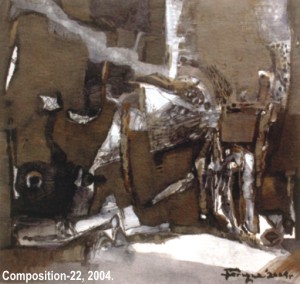 Faruque
is most eloquent in black and white. "I received a good
grounding in printmaking, and every artist with a background
in printmaking usually reveals the qualities often associated
with the mediums that they learn," says the artist. Technically
it is efficacious in printmaking to use one colour. Faruque
is most eloquent in black and white. "I received a good
grounding in printmaking, and every artist with a background
in printmaking usually reveals the qualities often associated
with the mediums that they learn," says the artist. Technically
it is efficacious in printmaking to use one colour.
It was
in 1980 that he completed his BFA from the department of Printmaking,
Institute of Fine Arts, Dhaka. Then he went on to study further
in the same principle in Beijing, China. After returning home,
he took up the job of teaching as an Assistant Professor,
Department of Fine Arts, University Rajshahi. His works remained
unexposed for several years. "I continued doing these
akibuki (sketches) whenever I had time and whenever I felt
like," declares Faruque. Yet his works suggest that a
lot was invested in them both in terms of labour and attention.
Consummate
dexterity with signs of serious contemplation, this is what
lends most of his works the joie de vivre that they announce
in a soft, well-modulated voice. Dexterity alone may not have
made his mostly "ink and wash" and "acrylic"
works imbued with such emotional fervour, his engagement with
them certainly has.
--Mustafa
Zaman
 Sunny
Side Up Sunny
Side Up
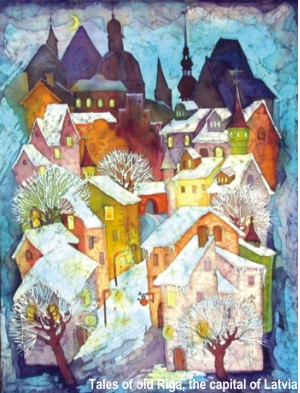 All
things in their unspoiled child-like characteristic look tender
and touchable. So is the world of 45 year old Russian artist
Liudmila Yakovleva. She had her first show of batik at the
Russian Centre of Science and Culture at Dhanmondi. All
things in their unspoiled child-like characteristic look tender
and touchable. So is the world of 45 year old Russian artist
Liudmila Yakovleva. She had her first show of batik at the
Russian Centre of Science and Culture at Dhanmondi.
In the
midst of all the images that bear the distinct smack of the
fairytale world, one cannot help resist the wave of nostalgia
that inundates the senses. The Russians were once famous for
their fairytales. In the 60s and the 70s they flooded the
world with publications that opened a door to that wonderful
world, and Yakovleva's work keep that fading trail alive at
least in visual terms.
In person
she too seems to exude the aura that garlands the world of
fairytale. With her limpid eyes and child-like simplicity
she embodies the peachy-cheeked heroines of fairytales. "Whatever
I do it always stems from the ancient art of Russia,"
she explains.
It is
understandable that Illia Repin, the late 19th century Russian
artist famous for his realistic depiction of Cossack life,
is someone she is not comfortable with. For her, Giotto, the
early Renaissance Italian Master, and the natives--- Serov,
Korovin and Lentulov provide the antidote.
 "Batik
is not the only medium that I work with. I studied textile
art, but I also practice water colour, acrylic and printmaking"
says Yakovleva. And it is apparent from the pictures that
were on display in the gallery that her background in textile
art dictates her pictorial dictions. The bright yet soothing
colours come from that experience. Another aspect is the distinct
depiction of all elements that make her works look spacious.
Each work is like a window framing a scene that has this illusion
of depth of field. In batik this is an accomplishment. "Batik
is not the only medium that I work with. I studied textile
art, but I also practice water colour, acrylic and printmaking"
says Yakovleva. And it is apparent from the pictures that
were on display in the gallery that her background in textile
art dictates her pictorial dictions. The bright yet soothing
colours come from that experience. Another aspect is the distinct
depiction of all elements that make her works look spacious.
Each work is like a window framing a scene that has this illusion
of depth of field. In batik this is an accomplishment.
Yakovleva
tackled real world in the same dream-like manner. Her works
on Egypt and Greece only reaffirm her affinity with the world
full with heroic figures pursueing righteousness. Strife is
the last thing in her mind, as she has the knack of giving
voice to things that are tender but secure in the deepest
recesses of our mind.
"I
have been travelling around. It is my first visit to Bangladesh
I would like to come back to have a show of my graphic works,"
she enthusiastically adds. Once back home she intends to work
on a series of batik based on Dhaka. Yakovleva's show was
open to the public from 17 to 23 February.
Mustafa
Zaman
Copyright
(R) thedailystar.net 2004
| 